Influence of SV Wave Oblique Incidence on the Dynamic Response of Arch Dams Under Canyon Contraction
Abstract
1. Introduction
2. Analysis Model
2.1. Finite Element Model of the Arch Dam–Foundation System
2.2. Material Model
2.3. Static and Dynamic Loads
2.4. Seismic Load and Seismic Input Methods
3. SV Wave Obliquely Incident Along the River Direction
3.1. Influence of Canyon Contraction on the Static and Dynamic Comprehensive Displacement of Arch Dams Under SV Wave Obliquely Incident Along the River Direction
3.2. Influence of the Incident Angle on the Static and Dynamic Comprehensive Displacement of the Arch Dam
3.3. Arch Dam Damage
4. SV Wave Incidence Obliquely Along the Cross-River Direction
4.1. Influence of Canyon Contraction on the Static and Dynamic Comprehensive Displacement of Arch Dams Under SV Wave Incidence Obliquely Along the Cross-River Direction
4.2. Influence of the Incidence Angle on the Static and Dynamic Comprehensive Displacement of the Arch Dam
4.3. Influence of the Incident Direction on the Damage Cracking of Arch Dams
5. Conclusions
- (1)
- When SV waves are obliquely incident along a river, canyon contraction has a significant influence on the displacement of the dam crest and arch crown beam. The increase in canyon contraction results in an increase in the static and dynamic comprehensive displacements of the dam crest and arch crown beam. Compared with that under no canyon contraction, the maximum displacement of the dam crest and crown beam under the vertical incidence of seismic waves increased by 10%, 24%, and 39%, respectively, when the canyon contraction was 20 mm, 40 mm, and 60 mm.
- (2)
- When SV waves are obliquely incident along a river, the variation law of the maximum displacement of the arch dam with the incident angle is consistent with the variation law of the ground motion amplification factor at the surface with the incident angle. The maximum displacement of the arch dam decreases when the incident angle is within the range of 0~35° and sharply increases when the incident angle is within the range of 35~37°. However, the maximum displacement at each incident angle is smaller than that at an incident angle of 0°. These results indicate that the vertical incidence of SV waves is the most unfavourable incidence mode affecting the static and dynamic comprehensive displacements of arch dams.
- (3)
- When SV waves are obliquely incident along the river, the degree of damage to and cracking of the dam is most severe when the canyon contraction is 60 mm and the incident angle is 0°. The degree of damage and cracking of the dam is the lowest when the canyon contraction is 0 mm and the incident angle is 35°. In the first case, the damage and cracking index of the dam increased by 7.6% compared with the case where the canyon contraction was 0 mm and the incident angle was 0°. In the second case, it decreased by 13.2 times compared with the case where the canyon contraction is 0 mm, and the incident angle is 0°. The degree of dam damage varied greatly among the three cases. In addition, the change in canyon contraction under the vertical incidence of seismic waves has a relatively small influence on dam damage. Owing to the asynchronous motion of the same elevation dam under an oblique incidence of seismic waves along the river, the variation in canyon contraction under such conditions has a significant influence on the degree of damage to the dam. Therefore, it is necessary to consider the influence of canyon contraction on the damage to and cracking of a dam under an oblique incidence of SV waves.
- (4)
- The static and dynamic comprehensive displacement distribution of the dam crest under SV wave incidence obliquely along the cross-river direction is different from that under SV wave incidence obliquely along the river. The maximum displacement of the dam crest under SV wave incidence obliquely along the cross-river direction occurs near the wave-backing side of the dam shoulder. The maximum displacement of the middle part of the dam crest and the arch crown beam under the same canyon contraction and incidence angle is smaller than under SV wave incidence obliquely along the river, and the damage cracking index of the dam is also 2–5 times smaller than under SV wave incidence obliquely along the river.
- (5)
- Comprehensively considering the influences of canyon contraction and seismic wave oblique incidence on the seismic design and safety of arch dams in near-fault strong earthquake zones is necessary. The finite element model of the arch dam in this paper does not consider the transverse joints between the dam sections. In subsequent research, the influences of canyon contraction and seismic wave oblique incidence on the opening of transverse joints will be further analysed.
Author Contributions
Funding
Data Availability Statement
Acknowledgments
Conflicts of Interest
References
- Chen, D.H.; Yang, Z.H.; Wang, M.; Xie, J.H. Seismic performance and failure modes of the Jin’anqiao concrete gravity dam based on incremental dynamic analysis. Eng. Fail. Anal. 2019, 100, 227–244. [Google Scholar] [CrossRef]
- Sadeghi, N.; Mirzabozorg, H. Safety analysis and seismic behavior of concrete arch dams (V&Ushaped dams). J. Civil Eng. Mater. Appl. 2023, 7, 169–183. [Google Scholar]
- Zhang, M.Z.; Wang, X.C.; Liu, Y.L.; Wang, J.T.; Yi, K.; Yan, J.H.; Chen, H.J. Effect of attached outlets on the dynamic response of arch dams. Eng. Struct. 2024, 302, 117392. [Google Scholar] [CrossRef]
- Zhang, J.W.; Li, M.C.; Han, S. Seismic analysis of gravity dam-layered foundation system subjected to earthquakes with arbitrary incident angles. Int. J. Geomech. 2022, 22, 04021279. [Google Scholar] [CrossRef]
- Fan, G.; Zhang, L.M.; Li, X.Y.; Fan, R.L.; Zhang, J.J. Dynamic response of rock slopes to oblique incident SV waves. Eng. Geol. 2018, 247, 94–103. [Google Scholar] [CrossRef]
- Du, X.L.; Xu, H.B.; Zhao, M. Analysis on seismic responses of high arch dam to SV waves of oblique incidence. J. Hydroelectr. Eng. 2015, 34, 139–145. (In Chinese) [Google Scholar]
- García, F.; Aznárez, J.J.; Padrón, L.A.; Maeso, O. Relevance of the incidence angle of the seismic waves on the dynamic response of arch dams. Soil Dyn. Earthq. Eng. 2016, 90, 442–453. [Google Scholar] [CrossRef]
- Zhang, T.R.; Xu, Q.; Chen, J.Y.; Li, J. Nonlinear seismic response and index correlation of high arch dams under cross-stream oblique incidence of near-fault SV waves based on wavelet decomposition. Soil Dyn. Earthq. Eng. 2023, 164, 107635. [Google Scholar] [CrossRef]
- Chen, D.H.; Pan, Z.Y.; Zhao, Y.Y. Seismic damage characteristics of high arch dams under oblique incidence of SV waves. Eng. Fail. Anal. 2023, 152, 107445. [Google Scholar] [CrossRef]
- Zhang, J.W.; Zhang, M.X.; Li, M.C.; Min, Q.L.; Shi, B.W.; Song, L.G. Nonlinear dynamic response of a CCRCC combined dam structure under oblique incidence of near-fault ground motions. Appl. Sci. 2020, 10, 885. [Google Scholar] [CrossRef]
- Song, Z.Q.; Wang, F.; Li, Y.L.; Liu, Y.H. Nonlinear seismic responses of the powerhouse of a hydropower station under near-fault plane P-wave oblique incidence. Eng. Struct. 2019, 199, 109613. [Google Scholar] [CrossRef]
- Wang, F.; Song, Z.Q.; Liu, Y.H.; Li, C.; Li, Z.G. Seismic response of embankment dams with asphalt concrete cores based on the three-dimensional time-domain inversion of ground motions. Int. J. Geomech. 2024, 34, 04024012. [Google Scholar] [CrossRef]
- Sun, B.B.; Wang, P.X.; Deng, M.J.; Fang, H.Y.; Xu, J.; Zhang, S.R.; Wang, C. Seismic performance assessment of hydraulic tunnels considering oblique incoming nonstationary stochastic SV waves based on the generalized PDEM. Tunn. Undergr. Space Technol. 2024, 143, 105481. [Google Scholar] [CrossRef]
- Ehrbar, H.; Bremen, R.; Otto, B. Gotthard base tunnel–tunnelling in the influence zone of two concrete arch dams. Geomech. Tunn. 2010, 3, 428–441. [Google Scholar] [CrossRef]
- Barla, G.; Antolini, F.; Barla, M.; Mensi, E.; Piovano, G. Monitoring of the Beauregard landslide (Aosta Valley, Italy) using advanced and conventional techniques. Eng. Geol. 2010, 116, 218–235. [Google Scholar] [CrossRef]
- Wu, M.X.; Jiang, H.; Zhang, C.H. General rules of dam-valley deformation due to reservoir impoundment. J. Hydroelectr. Eng. 2019, 38, 1–14. (In Chinese) [Google Scholar]
- Sun, G.H.; Lin, S.; Cheng, S.G.; Sun, T. Mechanisms of interaction between an arch dam and abutment slope using physical model tests. Rock Mech. Rock Eng. 2018, 51, 2483–2504. [Google Scholar] [CrossRef]
- Zhang, X.; Xiao, J.D.; Lin, Y.F.; Zhao, D.P. Valley deformation analysis for a high arch dam in Jinsha river, China. Arab. J. Geosci. 2021, 14, 1374. [Google Scholar] [CrossRef]
- Xu, L.D.; Rong, G.; Qiu, Q.Y.; Zhang, H.Q.; Chen, W.F.; Chen, Z.H. Analysis of reservoir slope deformation during initial impoundment at the Baihetan Hydropower Station, China. Eng. Geol. 2023, 323, 107201. [Google Scholar] [CrossRef]
- Rong, G.; Xu, L.D.; Yu, S.; Chen, W.F. The mechanism of large-scale river valley deformation induced by impoundment at the Baihetan Hydropower Station. Comput. Geotech. 2024, 165, 105898. [Google Scholar] [CrossRef]
- Li, M.W.; Zhou, Z.F.; Zhuang, C.; Zhou, Z.W. Deformation mechanism and model of river valley contraction of the Xiluodu reservoir, China. Environ. Earth. Sci. 2022, 81, 491. [Google Scholar] [CrossRef]
- Cheng, L.; Liu, Y.R.; Yang, Q.; Pan, Y.W.; Lv, Z. Mechanism and numerical simulation of reservoir slope deformation during impounding of high arch dams based on nonlinear FEM. Comput. Geotech. 2017, 81, 143–154. [Google Scholar] [CrossRef]
- Chai, D.; Cheng, H.; Mao, Y.P.; Zhang, G.X.; Yang, B.; Zhou, Q.J.; Liu, Y. Analysis of real deformation characteristics and influencing factors of ultra-high arch dam under action of valley shrinkage. Water Resour. Power. 2022, 40, 107–110. (In Chinese) [Google Scholar]
- Yang, X.C.; Gao, K.J.; Zhao, W.G.; Wang, R.K.; Zhang, J.H. Influence of valley deformation on safety of Xiluodu arch dam. J. Water Resour. Archit. Eng. 2018, 16, 72–78. (In Chinese) [Google Scholar] [CrossRef][Green Version]
- Gao, K.J.; Zhao, W.G.; Wang, R.K.; Zhang, J.H. Influence of valley contraction on deformation and stress state of high arch dam. Sci. Technol. Eng. 2018, 18, 92–100. (In Chinese) [Google Scholar]
- Pan, J.W.; Wang, J.T. Effect of abutment movements on nonlinear seismic response of an arch dam. Struct. Infrastruct. E 2020, 16, 1106–1120. [Google Scholar] [CrossRef]
- Lubliner, J.; Oliver, J.; Oller, S.; Onate, E. A plastic-damage model for concrete. Int. J. Solids Struct. 1989, 25, 299–326. [Google Scholar] [CrossRef]
- Zhai, Y.F.; Zhang, L.J.; Cui, B.H.; Zhang, H.Y.; Ma, T.X. Evolution criteria of overall damage of concrete gravity dam body and foundation under near-fault ground motion. Structures 2022, 43, 594–605. [Google Scholar] [CrossRef]
- NB/T 35047-2015; Code for Seismic Design of Hydraulic Structures in Hydropower Engineering. CREEI China Renewable Energy Engineering Institute: Beijing, China, 2015. (In Chinese)
- Zhang, G.X.; Cheng, H.; Zhou, Q.J.; Liu, Y.Y. Analysis of mechanism of valley creep deformation of high arch dam during impoundment. China Sciencepaper 2019, 14, 77–84. (In Chinese) [Google Scholar]
- Yuan, R.; Qiu, Y.X.; Wang, J.T.; Shi, H.T. Effects of canyon contraction and reservoir stage on Xiluodu arch dam dynamic response. J. Hydroelectr. Eng. 2022, 41, 50–58. (In Chinese) [Google Scholar]
- Wang, F.; Song, Z.Q.; Liu, Y.H.; Li, C. Seismic response of a rockfill dam with an asphalt–concrete core under P waves with arbitrary incident angles. Int. J. Geomech. 2023, 23, 04023076. [Google Scholar] [CrossRef]
- Sun, B.B.; Deng, M.J.; Zhang, S.R.; Wang, C.; Du, M. Seismic performance assessment of high asphalt concrete core rockfill dam considering shorter duration and longer duration. Structures 2022, 39, 1204–1207. [Google Scholar] [CrossRef]
- Huang, J.Q.; Du, X.L.; Jin, L.; Zhao, M. Impact of incident angles of P waves on the dynamic responses of long lined tunnels. Earthq. Eng. Struct. Dyn. 2016, 45, 2435–2454. [Google Scholar] [CrossRef]
- Li, M.C.; Zhang, J.W.; Zhang, M.X.; Min, Q.L.; Shi, B.W. Plastic damage response analysis of concrete gravity dam due to obliquely incident seismic waves. J. Hydraulic Eng. 2019, 50, 1326–1338+1349. [Google Scholar]
- Pan, X.H.; Wang, G.H.; Lu, W.B.; Wang, Y.; Shu, Y.Z.; Zhang, X.Y. Blast performance and damage evaluation of high arch dams subjected to far-field underwater explosions: Consideration of joints. J. Struct. Eng. 2023, 149, 04022263. [Google Scholar] [CrossRef]



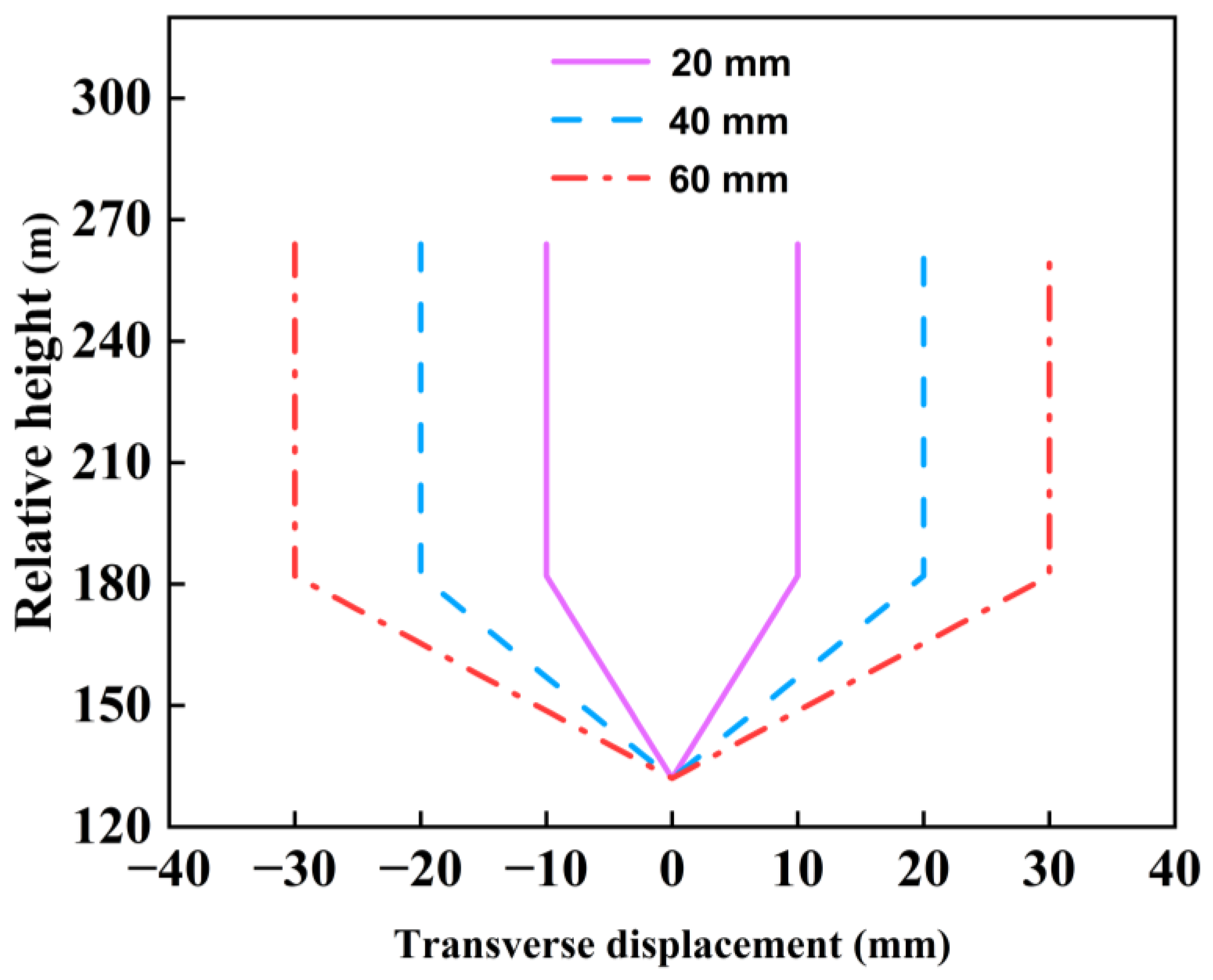
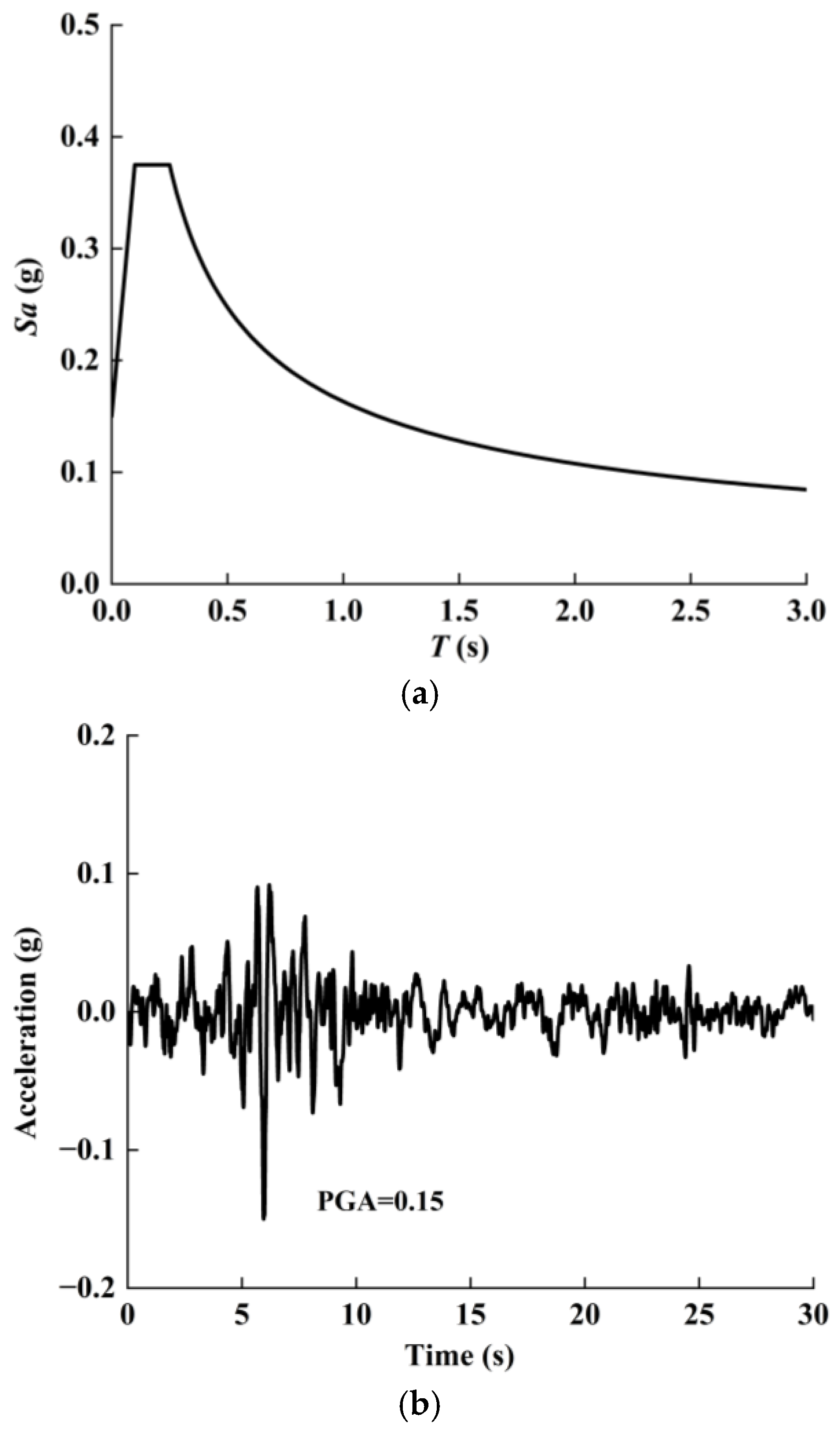
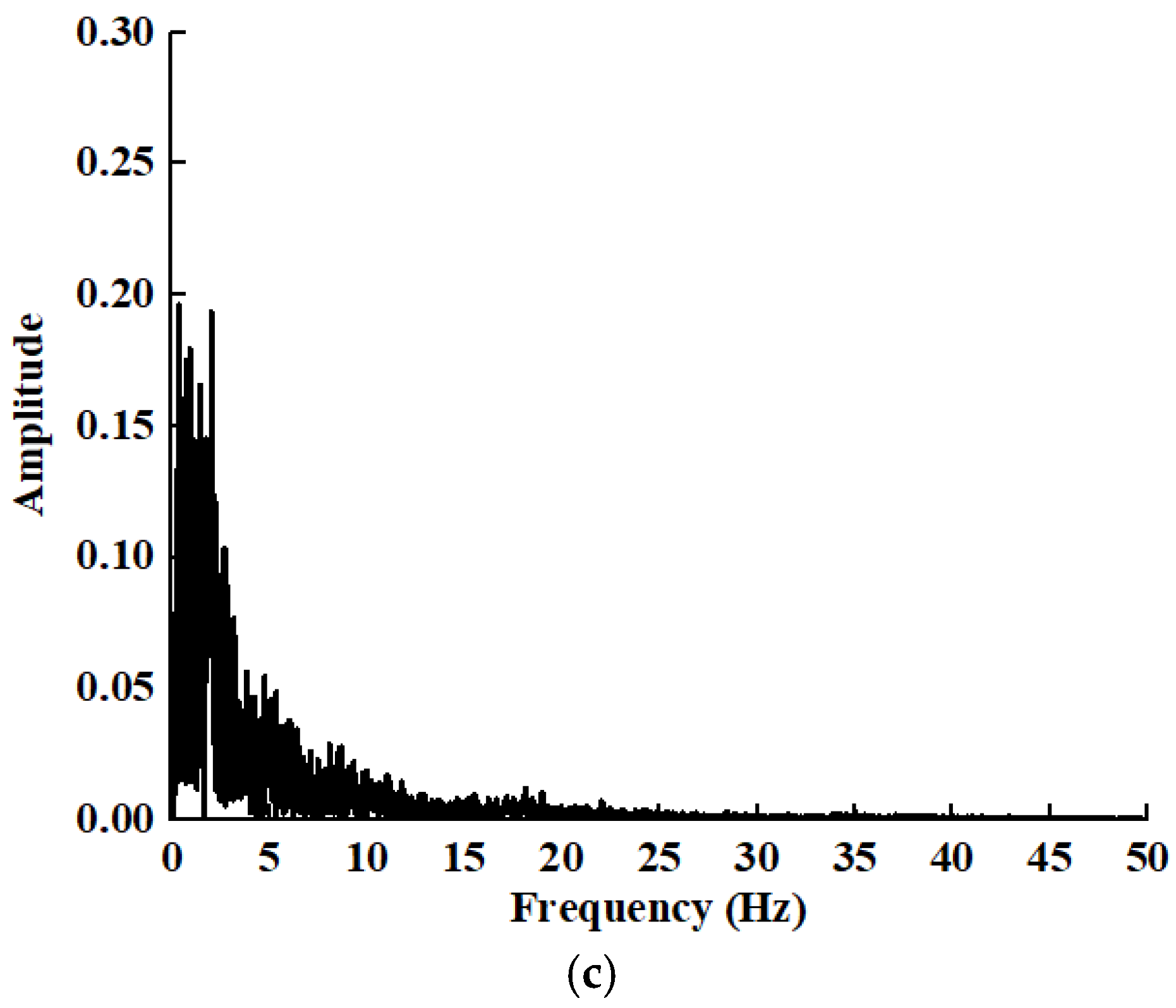
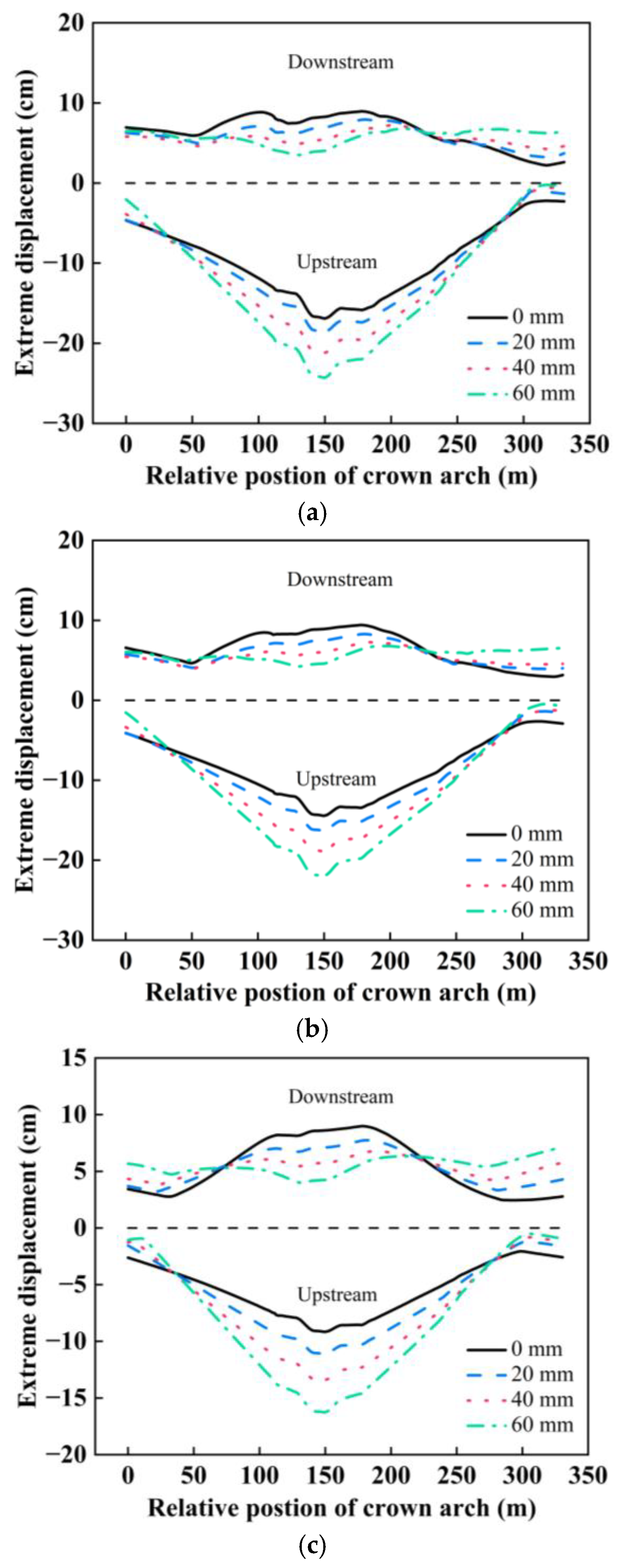
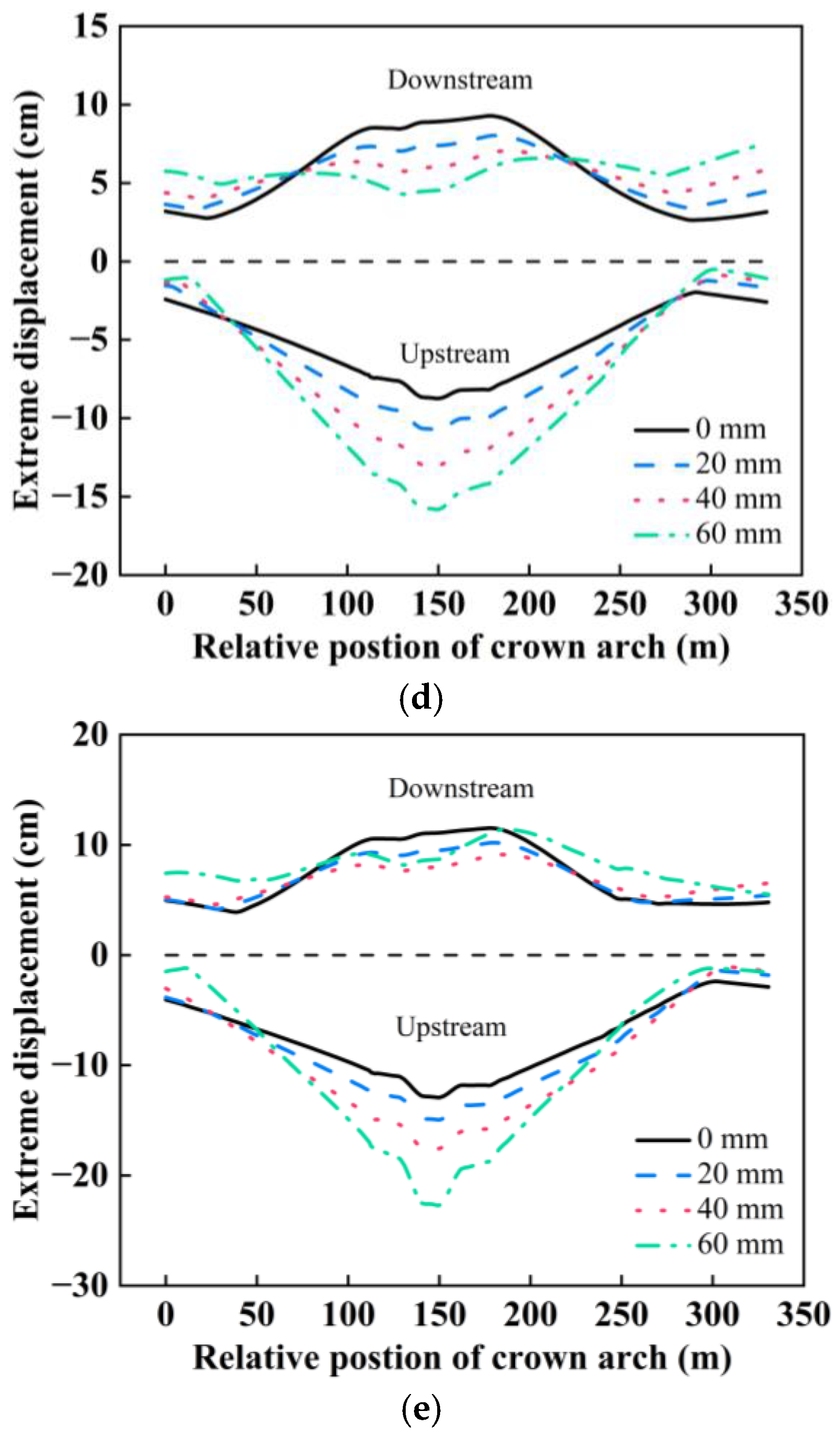

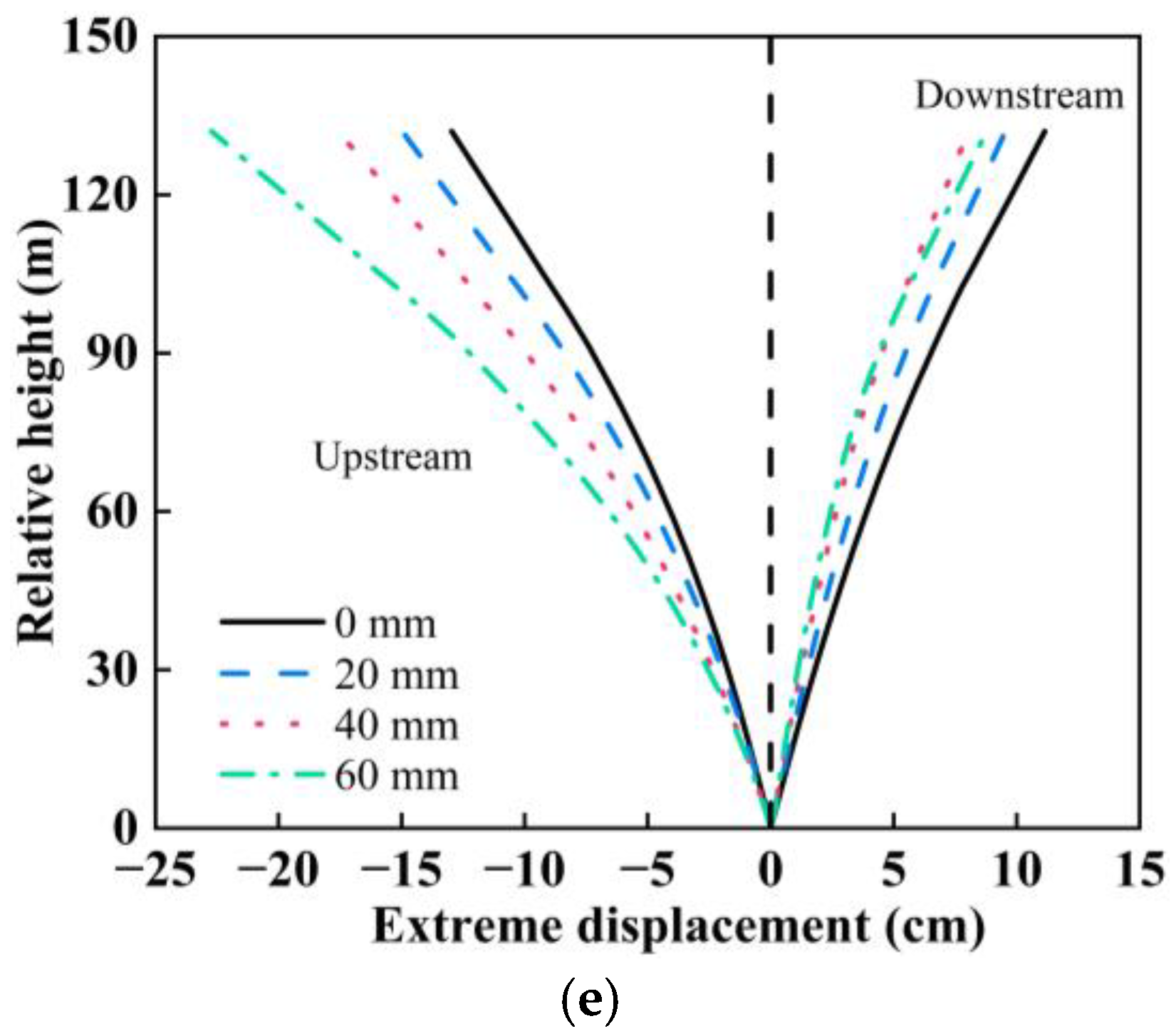


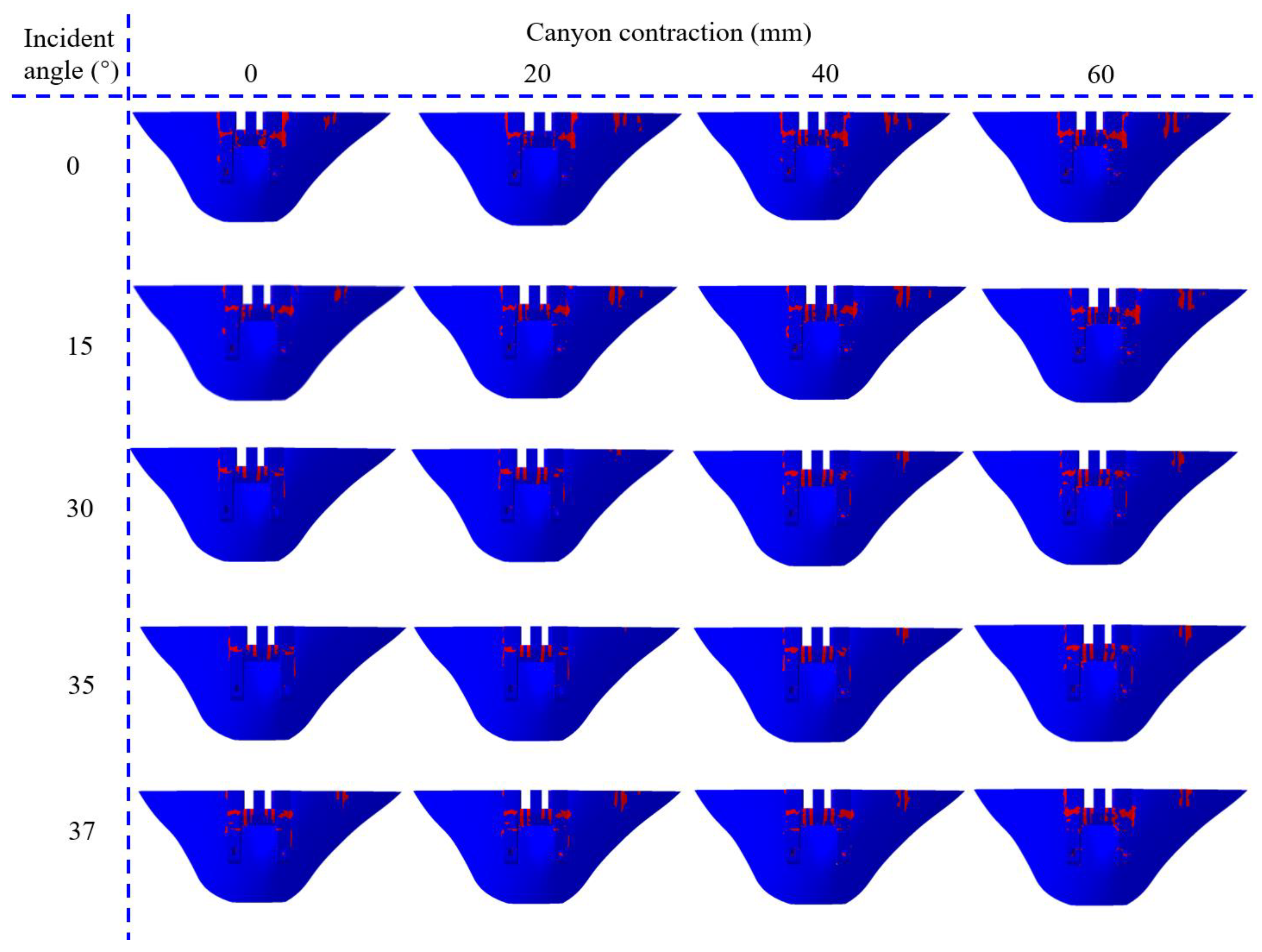
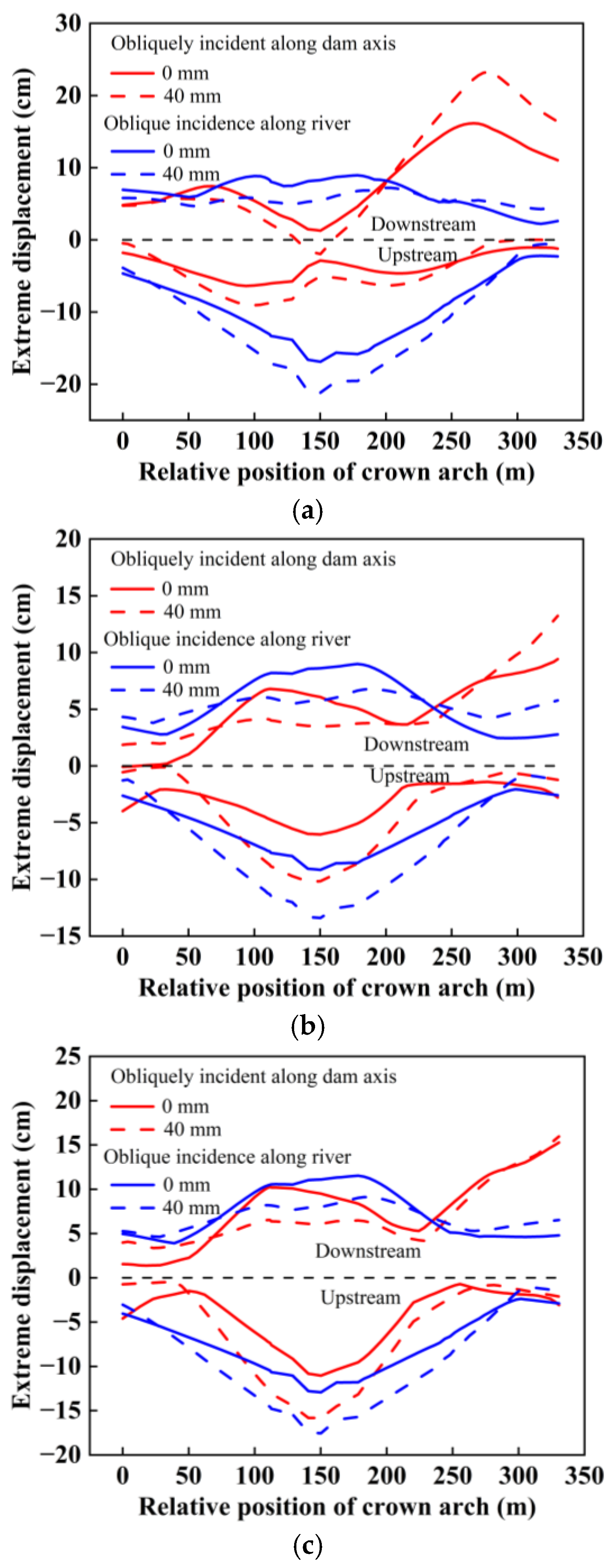
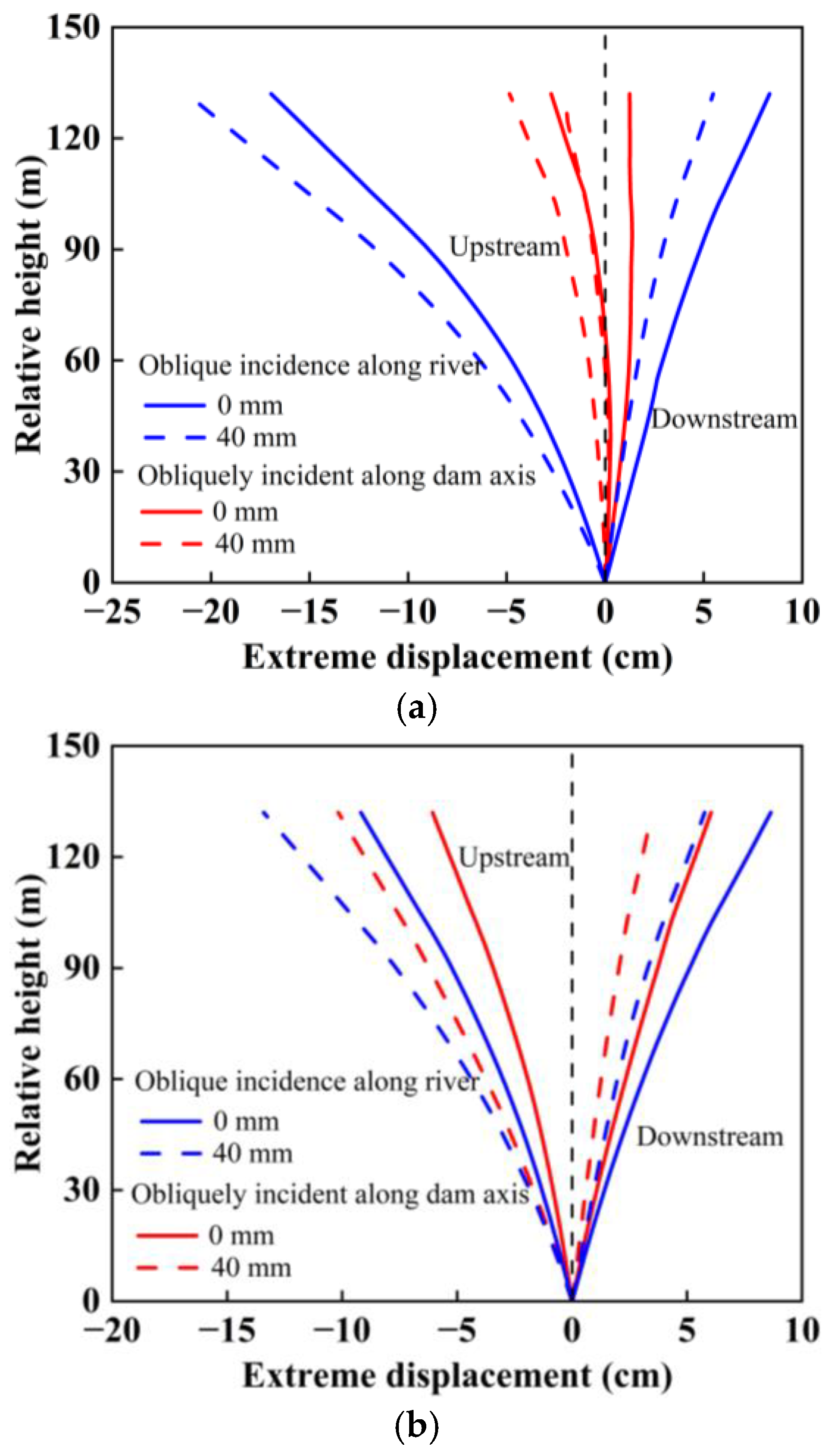
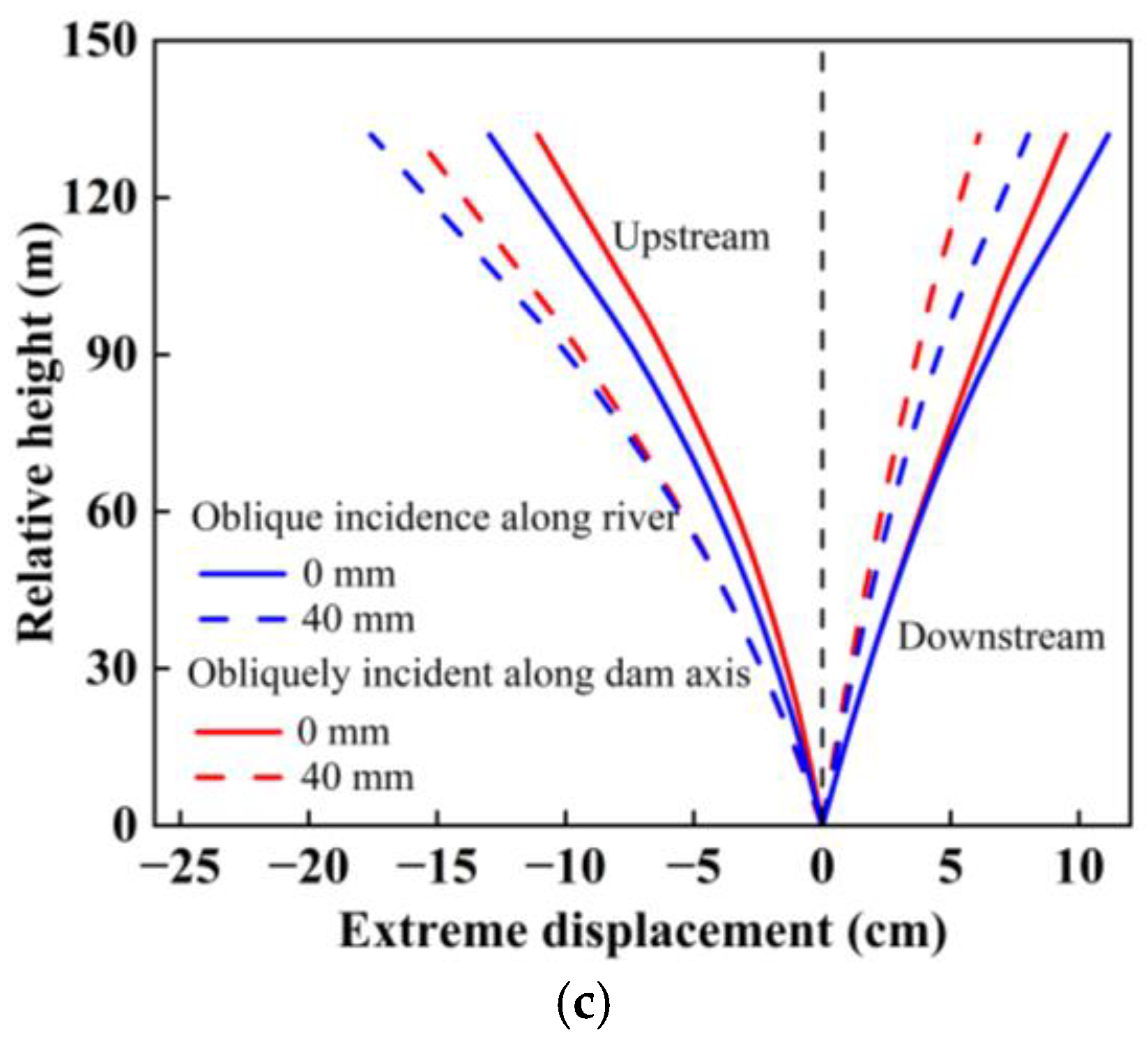
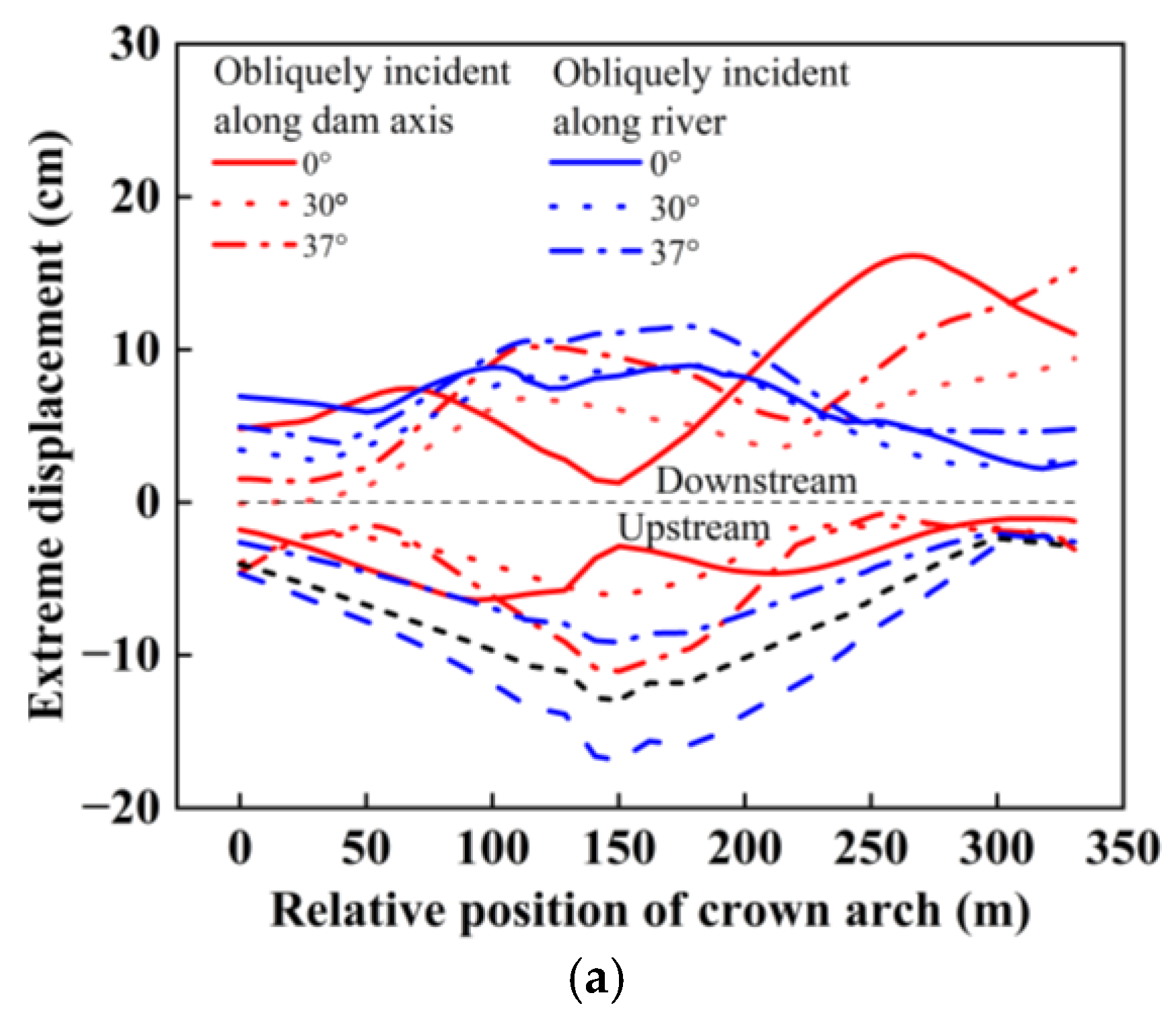
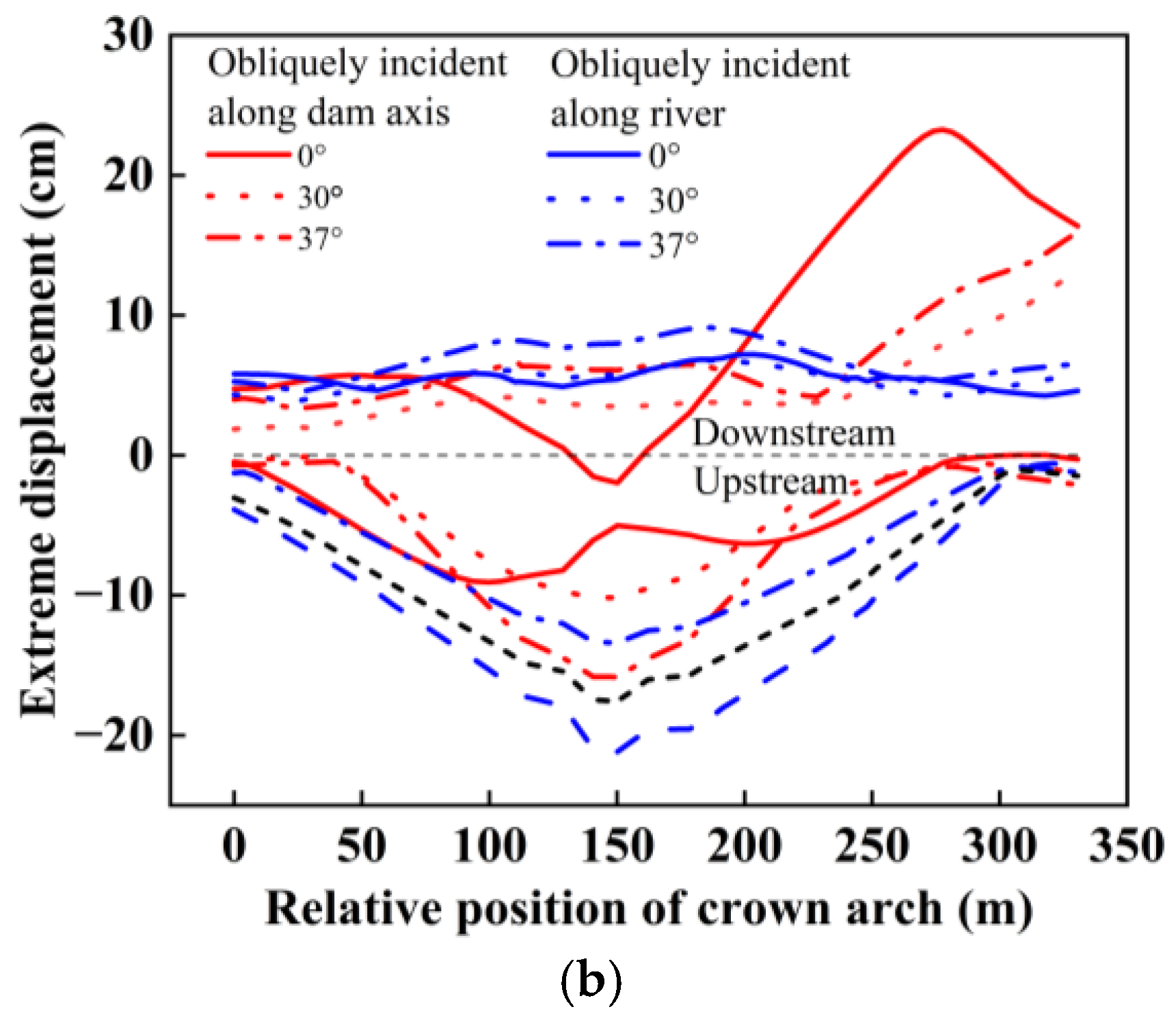

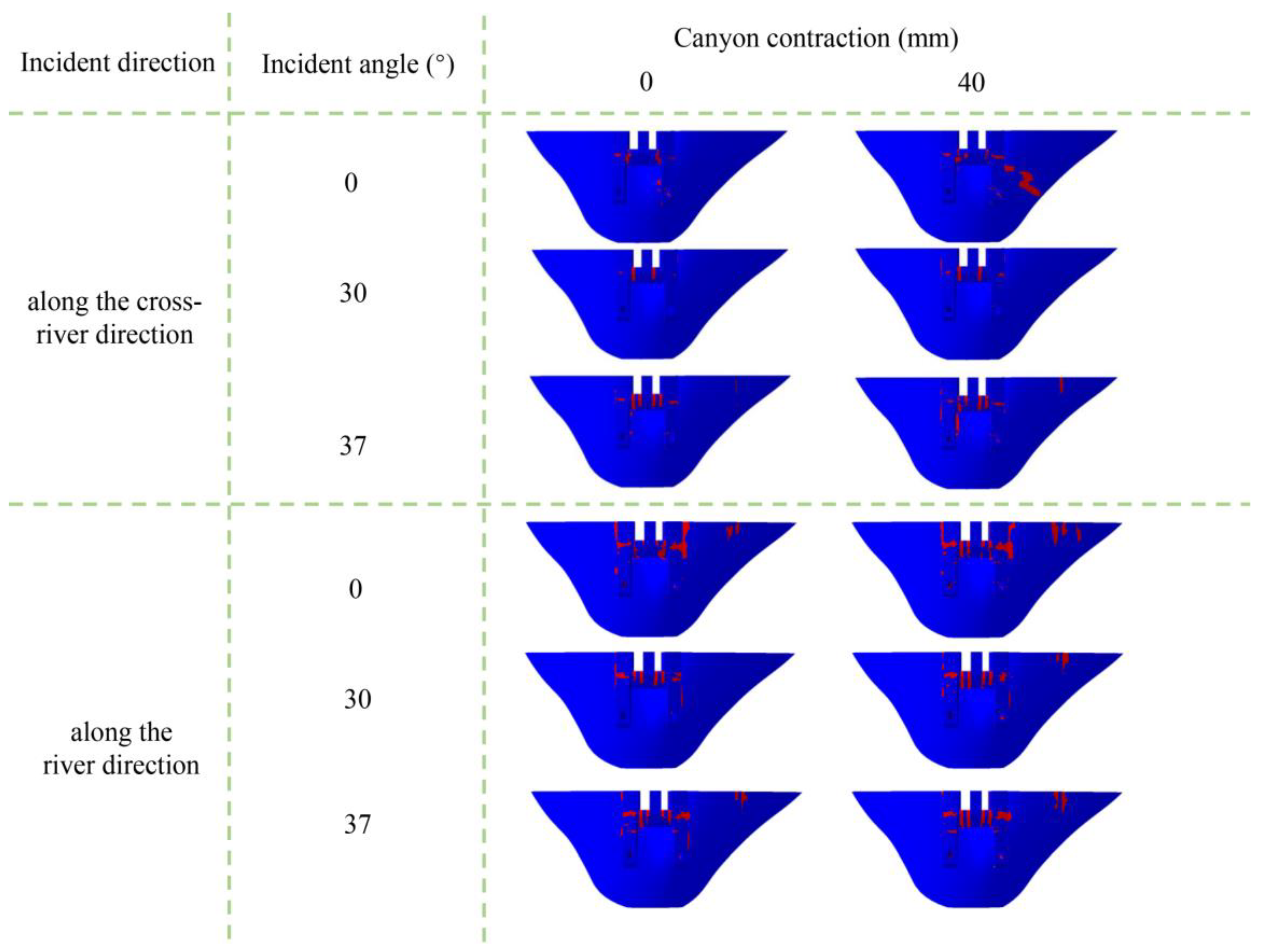
| Incident Direction | Canyon Contraction (mm) | Incident Angle (°) | ||
|---|---|---|---|---|
| 0 | 30 | 37 | ||
| cross-river | 0 | 0.97 | 0.16 | 0.59 |
| 40 | 2.04 | 0.17 | 0.62 | |
| river | 0 | 5.26 | 0.42 | 1.55 |
| 40 | 5.17 | 0.73 | 2.02 | |
Disclaimer/Publisher’s Note: The statements, opinions and data contained in all publications are solely those of the individual author(s) and contributor(s) and not of MDPI and/or the editor(s). MDPI and/or the editor(s) disclaim responsibility for any injury to people or property resulting from any ideas, methods, instructions or products referred to in the content. |
© 2024 by the authors. Licensee MDPI, Basel, Switzerland. This article is an open access article distributed under the terms and conditions of the Creative Commons Attribution (CC BY) license (https://creativecommons.org/licenses/by/4.0/).
Share and Cite
Wang, F.; Yang, Z.; Song, Z.; Liu, Y.; Tan, Y.; Liu, X. Influence of SV Wave Oblique Incidence on the Dynamic Response of Arch Dams Under Canyon Contraction. Water 2024, 16, 3630. https://doi.org/10.3390/w16243630
Wang F, Yang Z, Song Z, Liu Y, Tan Y, Liu X. Influence of SV Wave Oblique Incidence on the Dynamic Response of Arch Dams Under Canyon Contraction. Water. 2024; 16(24):3630. https://doi.org/10.3390/w16243630
Chicago/Turabian StyleWang, Fei, Zhen Yang, Zhiqiang Song, Yunhe Liu, Yuxian Tan, and Xiaoqing Liu. 2024. "Influence of SV Wave Oblique Incidence on the Dynamic Response of Arch Dams Under Canyon Contraction" Water 16, no. 24: 3630. https://doi.org/10.3390/w16243630
APA StyleWang, F., Yang, Z., Song, Z., Liu, Y., Tan, Y., & Liu, X. (2024). Influence of SV Wave Oblique Incidence on the Dynamic Response of Arch Dams Under Canyon Contraction. Water, 16(24), 3630. https://doi.org/10.3390/w16243630





